南京大学:《高级算法 Advanced Algorithms》课程教学资源(课件讲稿)04 Hashing and Sketching
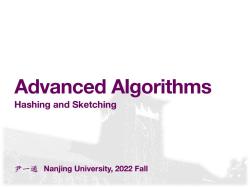
Advanced Algorithms Hashing and Sketching 尹一通Nanjing University,2022Fall
尹⼀通 Nanjing University, 2022 Fall Advanced Algorithms Hashing and Sketching

Count Distinct Elements Input:a sequence,,...,=[N] Output:an estimation of= {x,,} Data stream model:input data item comes one at a time x12 Xn Algorithm an estimation of f,X)={,,,x} Naive algorithm:store all distinct data items using (log N)bits Sketch:(lossy)representation of data using space Lower bound (Alon-Matias-Szegedy):any deterministic(exact or approx.)algorithm must use (N)bits of space in the worst case
Count Distinct Elements Input: a sequence Output: an estimation of x1, x2,…, xn ∈ U = [N] z = {x1, x2, …, xn} • Data stream model: input data item comes one at a time • Naïve algorithm: store all distinct data items using bits • Sketch: (lossy) representation of data using space • Lower bound (Alon-Matias-Szegedy): any deterministic (exact or approx.) algorithm must use bits of space in the worst case Ω(zlog N) ≪ z Ω(N) x1 x2 xn Algorithm an estimation of f(x1,…, xn) = {x1, x2,…, xn}
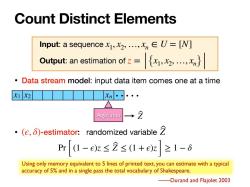
Count Distinct Elements Input:a sequence,,...,=[N] Output:an estimation of= {出,,} Data stream model:input data item comes one at a time X1 X2 Xn Algorithm 2 ·(e,δ)-estimator: randomized variable Pr1-ek≤2≤1+ez≥1-6 Using only memory equivalent to 5 lines of printed text,you can estimate with a typical accuracy of 5%and in a single pass the total vocabulary of Shakespeare. -Durand and Flajolet 2003
Count Distinct Elements • Data stream model: input data item comes one at a time • (ϵ, δ)-estimator: randomized variable Z ̂ Pr [ (1 − ϵ)z ≤ Z ̂ ≤ (1 + ϵ)z ] ≥ 1 − δ Using only memory equivalent to 5 lines of printed text, you can estimate with a typical accuracy of 5% and in a single pass the total vocabulary of Shakespeare. ——Durand and Flajolet 2003 x1 x2 xn Algorithm Z ̂ Input: a sequence Output: an estimation of x1, x2,…, xn ∈ U = [N] z = {x1, x2, …, xn}
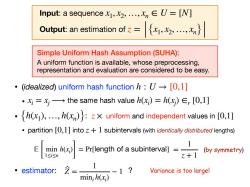
Input:a sequencex,,...,=[N] Output:an estimation of ={,2,,} Simple Uniform Hash Assumption(SUHA): A uniform function is available,whose preprocessing, representation and evaluation are considered to be easy. (idealized)uniform hash function h:U->[0,1] ·x:=x→the same hash value(x)=h(x)∈,[0,l] h),...,h:uniform and independent values in [,1] partition [0,1]into +1 subintervals (with identically distributed lengths) Prlongth of a subintervall 1 (by symmetry) 。estimator: 2= -1? Variance is too large! min;h(xi)
• (idealized) uniform hash function • the same hash value • : uniform and independent values in • partition into subintervals (with identically distributed lengths) h : U → [0,1] xi = xj⟶ h(xi ) = h(xj ) ∈r [0,1] {h(x1), …, h(xn)} z × [0,1] [0,1] z + 1 Simple Uniform Hash Assumption (SUHA): A uniform function is available, whose preprocessing, representation and evaluation are considered to be easy. 𝔼 [ min 1≤i≤n h(xi ) ] = Pr[length of a subinterval] = 1 z + 1 (by symmetry) • estimator: ? Z ̂ = 1 mini h(xi ) − 1 Variance is too large! Input: a sequence Output: an estimation of x1, x2,…, xn ∈ U = [N] z = {x1, x2, …, xn}
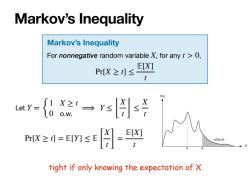
Markov's Inequality Markov's Inequality For nonnegative random variable X,for any t >0, E[X] Pr[X≥t1≤ t f(x) LetY= 1 X 0 PX≥0=n≤E月- E[X] p(Xza) tight if only knowing the expectation of X
Markov’s Inequality Markov’s Inequality For nonnegative random variable , for any , X t > 0 Pr[X ≥ t] ≤ 𝔼[X] t Let Y = { 1 X ≥ t 0 o.w. ⟹ Y ≤ ⌊ X t ⌋ ≤ X t Pr[X ≥ t] = 𝔼[Y] ≤ 𝔼 [ X t ] = 𝔼[X] t tight if only knowing the expectation of X
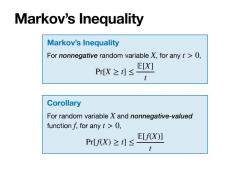
Markov's Inequality Markov's Inequality For nonnegative random variable X,for any t >0, E[X] Pr[X≥t]≤ t Corollary For random variable X and nonnegative-valued function f,for any t >0, E[f(X)] Pr[fX)≥t]≤ t
Markov’s Inequality Markov’s Inequality For nonnegative random variable , for any , X t > 0 Pr[X ≥ t] ≤ 𝔼[X] t Corollary For random variable and nonnegative-valued function , for any , X f t > 0 Pr[f(X) ≥ t] ≤ 𝔼[f(X)] t
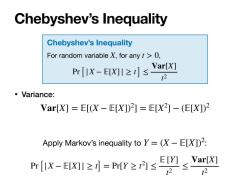
Chebyshev's Inequality Chebyshev's Inequality For random variable X,for any t >0, Var[X] Pr[IX-EX川≥t]≤ 2 ·Variance: Var[X]=E[(X-E[X])2]=EX2]-(E[X])2 Apply Markov's inequality to Y=(X-E[X])2: Pr[IX-EWI≥=PY≥内Er Yarlx] 12 2
Chebyshev’s Inequality Chebyshev’s Inequality For random variable , for any , X t > 0 Pr[|X − 𝔼[X]| ≥ t] ≤ Var[X] t2 • Variance: Var[X] = 𝔼[(X − 𝔼[X]) 2 ] = 𝔼[X2 ] − (𝔼[X]) 2 Apply Markov’s inequality to Y = (X − 𝔼[X]) : 2 Pr[|X − 𝔼[X]| ≥ t] = Pr[Y ≥ t 2 ] ≤ 𝔼 [Y] t2 ≤ Var[X] t2
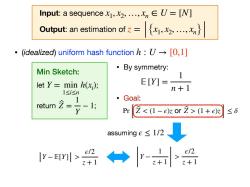
Input:a sequencex,..,U=[N] Output:an estimation of= ={x,2,,} ·(idealized)uniform hash function h:U→[0,l] Min Sketch: ·By symmetry: 1 let Y=1 min h(); E[Y]= n+1 1≤i≤n 1 Goal: return 2= -1; Pr②(1+e02 ≤6 assuming e≤1/2 ↓ y->¥ →本器
Pr [ Z ̂ (1 + ϵ)z ] ≤ δ • (idealized) uniform hash function h : U → [0,1] Min Sketch: let ; return ; Y = min 1≤i≤n h(xi ) Z ̂ = 1 Y − 1 • By symmetry: • Goal: 𝔼 [Y] = 1 n + 1 Y − 1 z + 1 > ϵ/2 z + 1 assuming ϵ ≤ 1/2 Y − 𝔼[Y] > ϵ/2 z + 1 Input: a sequence Output: an estimation of x1, x2,…, xn ∈ U = [N] z = {x1, x2, …, xn}
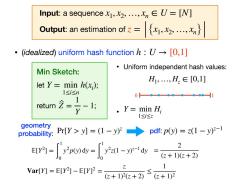
Input:a sequence,...,=[N] Output:an estimation of= ={x,2,,} ·(idealized)uniform hash function h:U→[0,l] Uniform independent hash values: Min Sketch: let Y=1 min h(); H1,,H2∈[0,1] 1≤i≤n 0— -01 1 return 2= 。Y=minH; 1≤i≤z geometry probability:Pr[Y>]=(1-y) pdf:p(y)=(1-y)2-1 =n0=2z1-yd= 2 (z+1)(z+2) Var[Y]=E[Y]-EYP=+1+2) 1 (3+1)2
• Uniform independent hash values: • H1, …, Hz ∈ [0,1] Y = min 1≤i≤z Hi 0 1 geometry probability: pdf: p(y) = z(1 − y) z−1 𝔼[Y2 ] = ∫ 1 0 y2p(y) dy = ∫ 1 0 y2z(1 − y) z−1 dy Pr[Y > y] = (1 − y) z = 2 (z + 1)(z + 2) Var[Y] = 𝔼[Y2 ] − 𝔼[Y] 2 = z (z + 1)2(z + 2) ≤ 1 (z + 1)2 • (idealized) uniform hash function h : U → [0,1] Min Sketch: let ; return ; Y = min 1≤i≤n h(xi ) Z ̂ = 1 Y − 1 Input: a sequence Output: an estimation of x1, x2,…, xn ∈ U = [N] z = {x1, x2, …, xn}
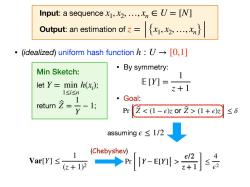
Input:a sequencex,...,U=[N] Output:an estimation of z= ·(idealized)uniform hash function h:U→[0,l] Min Sketch: ·By symmetry: 1 let Y=1 min h(); E[Y]= 1≤i≤n +1 1 Goal: return -1; Pr⑦(1+e3 ≤6 assuminge≤1/2 1 (Chebyshev) 4 Var[Y]≤ +p→n[-E>s
Y − 𝔼[Y] > ϵ/2 z + 1 Pr [ Y − 𝔼[Y] > ϵ/2 z + 1 ] ≤ 4 ϵ2 Pr [ Z ̂ (1 + ϵ)z ] ≤ δ assuming ϵ ≤ 1/2 Var[Y] ≤ 1 (z + 1)2 (Chebyshev) • (idealized) uniform hash function h : U → [0,1] • By symmetry: • Goal: 𝔼 [Y] = 1 z + 1 Input: a sequence Output: an estimation of x1, x2,…, xn ∈ U = [N] z = {x1, x2, …, xn} Min Sketch: let ; return ; Y = min 1≤i≤n h(xi ) Z ̂ = 1 Y − 1
按次数下载不扣除下载券;
注册用户24小时内重复下载只扣除一次;
顺序:VIP每日次数-->可用次数-->下载券;
- 南京大学:《高级算法 Advanced Algorithms》课程教学资源(课件讲稿)03 Balls into Bins.pdf
- 南京大学:《高级算法 Advanced Algorithms》课程教学资源(课件讲稿)02 Fingerprinting.pdf
- 南京大学:《高级算法 Advanced Algorithms》课程教学资源(课件讲稿)01 Introduction - Min-Cut and Max-Cut(尹⼀通).pdf
- 南京大学:《高级算法 Advanced Algorithms》课程教学资源(课件讲稿)03 Balls-into-Bins Model and Chernoff Bounds.pptx
- 《量子计算》课程教学资源(阅读文献)Lecture Notes on Quantum Algorithms(Andrew M. Childs).pdf
- 《量子计算》课程教学资源(阅读文献)Quantum Computation and Quantum Information(10th Anniversary Edition,Michael A. Nielsen & Isaac L. Chuang).pdf
- 《理论计算机科学》课程教学资源(阅读文献)Computational Complexity - A Modern Approach.pdf
- 《理论计算机科学》课程教学资源(阅读文献)Approximation via Correlation Decay when Strong Spatial Mixing Fails(HIS).pdf
- 《理论计算机科学》课程教学资源(阅读文献)Galton–Watson process - Branching.pdf
- 《理论计算机科学》课程教学资源(阅读文献)Analysis Of Boolean Functions(Ryan O’Donnell).pdf
- 南京大学:《概率论与数理统计 Probability and Statistics》课程教学资源(PPT课件讲稿)Lecture 14 假设检验.pptx
- 南京大学:《概率论与数理统计 Probability and Statistics》课程教学资源(PPT课件讲稿)Lecture 13 区间估计(参数估计).pptx
- 南京大学:《概率论与数理统计 Probability and Statistics》课程教学资源(PPT课件讲稿)Lecture 12 点估计(参数估计).pptx
- 南京大学:《概率论与数理统计 Probability and Statistics》课程教学资源(PPT课件讲稿)Lecture 11 统计量与抽样分布.pptx
- 南京大学:《概率论与数理统计 Probability and Statistics》课程教学资源(PPT课件讲稿)Lecture 10 极限理论.pptx
- 南京大学:《概率论与数理统计 Probability and Statistics》课程教学资源(PPT课件讲稿)Lecture 09 典型二维连续型随机变量、相关系数.pptx
- 南京大学:《概率论与数理统计 Probability and Statistics》课程教学资源(PPT课件讲稿)Lecture 08 典型连续型随机变量的分布.pptx
- 南京大学:《概率论与数理统计 Probability and Statistics》课程教学资源(PPT课件讲稿)Lecture 07 连续型随机变量.pptx
- 南京大学:《概率论与数理统计 Probability and Statistics》课程教学资源(PPT课件讲稿)Lecture 06 概率化方法(主讲:唐斌).pptx
- 南京大学:《概率论与数理统计 Probability and Statistics》课程教学资源(PPT课件讲稿)Lecture 05 条件期望、方差.pptx
- 南京大学:《高级算法 Advanced Algorithms》课程教学资源(课件讲稿)05 Concentration of measure.pdf
- 南京大学:《高级算法 Advanced Algorithms》课程教学资源(课件讲稿)06 Dimension Reduction.pdf
- 南京大学:《高级算法 Advanced Algorithms》课程教学资源(课件讲稿)07 Lovász Local Lemma.pdf
- 南京大学:《高级算法 Advanced Algorithms》课程教学资源(课件讲稿)08 Greedy and Local Search.pdf
- 南京大学:《高级算法 Advanced Algorithms》课程教学资源(课件讲稿)09 Rounding Dynamic Programs.pdf
- 南京大学:《高级算法 Advanced Algorithms》课程教学资源(课件讲稿)10 Rounding Linear Programs.pdf
- 南京大学:《高级算法 Advanced Algorithms》课程教学资源(课件讲稿)11 The Primal-Dual Schema.pdf
- 南京大学:《高级算法 Advanced Algorithms》课程教学资源(课件讲稿)12 SDP-Based Algorithms.pdf
- 电子科技大学:《图论及其应用 Graph Theory and its Applications》研究生课程教学资源(教学大纲,杨春).pdf
- 电子科技大学:《图论及其应用 Graph Theory and its Applications》研究生课程教学资源(课件讲稿)01 图论简介、图的定义及其相关概念、图的同构.pdf
- 电子科技大学:《图论及其应用 Graph Theory and its Applications》研究生课程教学资源(课件讲稿)02 完全图、偶图与补图、顶点的度与图的度序列.pdf
- 电子科技大学:《图论及其应用 Graph Theory and its Applications》研究生课程教学资源(课件讲稿)03 子图的相关概念、几种典型的图运算、路与连通性.pdf
- 电子科技大学:《图论及其应用 Graph Theory and its Applications》研究生课程教学资源(课件讲稿)04 图的代数表示、最短路算法.pdf
- 电子科技大学:《图论及其应用 Graph Theory and its Applications》研究生课程教学资源(课件讲稿)05 邻接谱、邻接代数与图空间、托兰定理.pdf
- 电子科技大学:《图论及其应用 Graph Theory and its Applications》研究生课程教学资源(课件讲稿)06 树的概念与应用、树的性质、树的中心与形心.pdf
- 电子科技大学:《图论及其应用 Graph Theory and its Applications》研究生课程教学资源(课件讲稿)07 生成树的概念与性质、生成树的计数、回路系统简介.pdf
- 电子科技大学:《图论及其应用 Graph Theory and its Applications》研究生课程教学资源(课件讲稿)08 克鲁斯克尔算法、管梅谷的破圈法、Prim算法、根树简介.pdf
- 电子科技大学:《图论及其应用 Graph Theory and its Applications》研究生课程教学资源(课件讲稿)09 图的连通性(割边、割点和块).pdf
- 电子科技大学:《图论及其应用 Graph Theory and its Applications》研究生课程教学资源(课件讲稿)10 网络的容错性参数.pdf
- 电子科技大学:《图论及其应用 Graph Theory and its Applications》研究生课程教学资源(课件讲稿)11 图的宽直径简介.pdf
